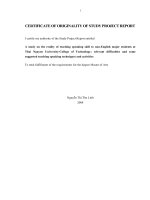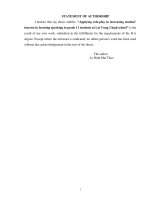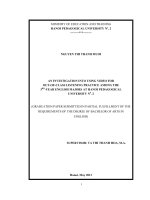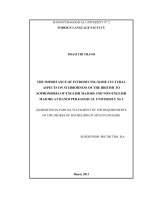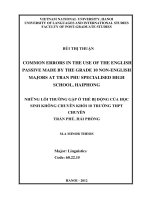An application of CLT principles in teaching speaking to non english majors at nghe an economics and technology college
Bạn đang xem bản rút gọn của tài liệu. Xem và tải ngay bản đầy đủ của tài liệu tại đây (513.18 KB, 98 trang )
MINISTRY OF EDUCATION AND TRAINING
VINH UNIVERSITY
Nguyễn thị lan hơng
An application of CLT principles in teaching speaking to non-English majors at
Nghe An Economics and Technology College.
Áp dụng các nguyên lý dạy ngơn ngữ giao tiếp trong việc dạy nói cho sinh viên không chuyên tiếng Ạnh tại
trường Cao đẳng kinh tế kỹ thuật Nghệ an
Master thesis in Education
Field: Theory and Methodology of English Language Teaching
Code: 60.14.10
Supervisor: Trần Bá Tiến
Vinh, 2011
i
Acknowledgement
First of all, I wish to express my sincere gratitude to my supervisor, Dr Tran
Ba Tien, for his valuable guidance, helpful suggestions, invaluable critical feedback
and encouragement in the writing of this research.
Also, I would like to acknowledge my gratitude to all the lecturers in the
English Department of Nghe An Economics and Technology College, for their
useful lessons from which I have benefited a lot for the accomplishment of this
study.I am greatly indebted to my students from class K6-10 and class K6-11 and
my colleagues for their participation and assistance without which this thesis could
not have been successful.
Finally, I would like to express my special thanks to my loving parents, my
husband, my sons and my close friends who offered me their love, care, support and
encouragement so that I could accomplish my study.
ii
Statement of authorship
I certify my authorship of the study report entitled
An application of CLT principles in teaching speaking to non-English
majors at Nghe An Economics and Technology College.
is the result of my own research for the degree of Master of Art at Vinh University,
and this thesis total fulfillment of the requirements for the degree Master of Arts.
Nguyễn thị lan hơng
2011
Supervisors signature
Trần B¸ TiÕn
iii
Abstract
This study is an attempt to investigate the application of CLT principles in
teaching speaking to non-English majors at Nghe An Economics and Technology
College. The main purposes of the study are to find out: the current English
speaking teaching and learning situation at Nghe An Economics and Technology
college; activities and techniques of CLT applied by teachers and students’
preferences; the difficulties in learning and teaching English speaking and then give
some suggestions for teachers to stimulate students in speaking and overcome the
difficulties they have to face with in teaching speaking English for students.
iv
TABLE OF CONTENT
Acknowledgement..................................................................................................ii
Statement of authorship..................................................................................iii
Abstract........................................................................................................................iv
TABLE OF CONTENT.......................................................................................................1
Lists of tables and charts..................................................................................5
Chapter 1: Introduction.......................................................................................6
1.1. Rationale..................................................................................6
1.2. Aims and objectives:................................................................8
1.3. Research questions:................................................................8
1.4. Scope of the study:..................................................................9
1.5. Significance of the study:.........................................................9
1.6. Organization of the study:........................................................9
1.7. Definitions of terms:...............................................................10
Chapter 2: Literature Review.........................................................................11
2.1. An overview of language learning..........................................11
2.1.1. Behaviorism...........................................................................................................11
2.1.2. Cognitivism............................................................................................................12
2.1.3. Constructivism.......................................................................................................12
2.2. Approaches to language teaching.........................................13
2.2.1. Grammar-translation method...............................................................................14
2.2.2. The direct method..................................................................................................14
2.2.3. The audio-lingual method.....................................................................................15
2.2.4. The communicative teaching method...................................................................16
2.3. Communicative language teaching........................................17
2.3.1. Definition of Communicative Language Teaching.............................................17
2.3.2. Distinguishing Features of CLT...........................................................................17
2.3.3. Condition of applying CLT...................................................................................19
2.3.4. Communicative competence..................................................................................20
2.4. The nature of speaking..........................................................23
2.4.1. Definition of speaking...........................................................................................23
2.4.2. Characteristics of a successful speaking..............................................................23
2.4.3. Problems with speaking activities and solutions..................................................24
2.5. Teaching Speaking................................................................26
2.5.1. Teaching speaking.................................................................................................26
2.5.2. Motivation in speaking in classroom....................................................................26
2.5.2.1. Motivation in the classroom setting....................................................................26
2.5.2.2. Factors making students reluctant to speak in classroom..................................27
1
2.5.2.3. Some conditions for effective motivation in speaking.........................................27
2.5.3. How to teach speaking..........................................................................................28
2.5.4. The teachers’ role in different stages of teaching speaking................................28
2.6. Goals and techniques for teaching speaking.........................30
2.6.1. Goals of teaching speaking...................................................................................30
2.6.2. Techniques.............................................................................................................31
2.6.3. Strategies for developing speaking skills..............................................................32
2.6.4. Applying techniques and activities of CLT...........................................................33
2.7. Summary:...............................................................................38
Chapter 3: Research Methodology.............................................................39
3.1. An overview of the research site............................................39
3.2. Research design:...................................................................39
3.3. Research method:..................................................................39
3.4. Participants:...........................................................................40
3.5. Data collection instruments:...................................................40
3.5.1. Survey questionnaires:..........................................................................................40
3.5.1.1. Questionnaires for students:............................................40
3.5.1.2. Questionnaires for teachers:............................................41
3.5.2. Class observation:..................................................................................................41
3.6. Data collection procedures:...................................................42
3.7. Summary................................................................................42
Chapter 4: Findings and discussion..............................................................43
4.1. Results from students’ pre-task questionnaire pre-task questionnaire.......................43
4.1.1. Students’ motivation and opinions on learning speaking English.....................43
Table 4.1: Types of motivation.........................................................................................43
4.1.2. Factors making students reluctant to speak English in class..............................46
Table 4.2: Factors making students reluctant to speak English in class.........................46
4.1.3. Factors increase students’ motivation in speaking English................................47
Table 4.3: Factors encourage students to speak English.................................................48
4.1.4. Activities used by teachers and students’ preference...........................................49
Table 4.4: What teachers do to motivate students to take part in speaking activities.....49
Table 4.5: Activities applied by the teachers and students’ preference...........................50
4.2. Results from students’ pre-task questionnaire post-task questionnaire.....................53
4.2.1. The changes of students’ motivation and attitude in English speaking skill......53
4.2.2. Factors increasing students’ motivation in English speaking skill.....................56
4.3. Results from teachers’ pre-task questionnaire survey questionnaire.........................57
4.3.1. Problems teachers often faced in teaching speaking English.............................57
4.3.2. Teachers’ opinion towards students' motivation in speaking English................58
2
4. 3. 3. Techniques and activities of CLT applied by teachers.......................................59
4.4. Results from class observation..............................................65
4.5. Summary:...............................................................................68
Chapter 5: conclusion and implications.................................................69
5.1. Summary of the study............................................................69
5.1. 1. Difficulties teachers have encountered in teaching speaking............................69
5.1.2. Factors making students unwilling to speak English in class.............................71
5.1. 3. Techniques and activities used by teachers.........................................................72
5.1. 4. Conclusion............................................................................................................73
5.2. Pedagogical implications.......................................................74
5.2.1. Promoting the students internal factors...............................................................74
5.2.2. Varying speaking activities...................................................................................75
5.2.3. Combining the textbook and relevant materials..................................................76
5.2.4. Setting up co-operative atmosphere in class........................................................76
5.2.5. Being enthusiastic, tolerant, helpful, creative and active....................................76
5.2.6. Aware of and satisfy students’ interest and desires..............................................76
5.2.7. Helping the students to improve their knowledge of grammar and enrich their
vocabulary........................................................................................................................77
5.2.8. Recognizing the potential value of available facilities of the school and the
Internet.............................................................................................................................77
5.3. Limitations and recommendations for further research..........79
Reference.....................................................................................................................80
Appendix 1..........................................................................................................................I
Survey Questionnaire For teachers............................................................I
Appendix 2.......................................................................................................................IV
Pre-task Questionnaire For students.......................................................IV
Appendix 3......................................................................................................................VII
Post-task Questionnaire For students...................................................VII
Appendix 4........................................................................................................................X
Lesson observation sheet..................................................................................X
Appendix 5:....................................................................................................................XII
Classroom observation checklist...........................................................XII
.....................................................................................................................................
3
Lists of tables and charts
List of tables
Table 4.1: Types of motivation………………………………………………………………………
Table 4.2: Factors making students reluctant to speak English in class………………………
Table 4.3: Factors encourage students to speak English……………………………………….
Table 4.4: What teachers do to motivate students to take part in speaking activities………
Table 4.5: Activities applied by the teachers and students’ preference………………………
Table 4.6: Activities enjoyed most by students…………………………………………………
Table 4.7: The changes of students’ motivation………………………………………………
Table 4.8: The changes of the factors making students reluctant to speak…………………..
Table 4.9: Problems teacher faced in teaching English speaking…………………………….
Table 4.10: Teachers’ opinions towards students’ motivation in speaking English……….
Table 4.11: Teachers’ opinions in creating good relationship with students………………..
Table 4.12: Techniques used by teachers to help students to be more active and interested in
speaking lessons………………………………………………………………………………………
Table 4.13: Teachers’ techniques to prevent students from using Vietnamese………………
Table 4.14: The frequency of teachers’ using communicative activities……………………..
Table 4.15: The frequency of teachers’ techniques to motivate students…………………….
Table 4.16: Result of class observations…………………………………………………………
List of charts
Chart 4.1: Students’ perceived importance of English…………………………………………..
Chart 4.2: Students’ interest in learning English…………………………………………………
Chart 4.3: Students’ frequency of speaking English in class time………………………………
Chart 4.4: Students’ result after the treatment……………………………………………………
4
Chapter 1: Introduction
1.1. Rationale
In this globalization era, English has an important role in the world. Most
countries in the world use English as medium of communication in many aspects of
life. Meanwhile, in Vietnam, English is considered as a foreign language (EFL). It
also has been introduced to educational institutions, which is learnt from Junior
High School up to university as a compulsory subject.
The ability to speak English has always become a very important goal for
learners of this language both its natural and foreign setting. In transferring of
language to students, appropriate techniques are needed in order to give new
atmosphere of class interaction. To make the students able to communicate in target
language, the English teachers should be aware of implementing classroomspeaking process. It can be assumed that English teachers are required to be well
prepared before performing the lesson through supported activities in order to
impress the students’ motivation in achieving the skill on speaking. Thus,
communicative language teaching will run more effectively and efficiently.
Since 1986, Vietnam’s economic and political situation has
led to radical changes in Vietnamese education and training in
general, and in English language teaching (ELT) in particular. The
national reform policy since the 6th Congress of the Communist
Party of Vietnam (CPV), December 1986 signposted a significant
change in the socio-economic situation of modern Vietnam,
orienting this country towards modernization and industrialization with a
multi-sector commodity economy (Le & Sloper, 1995). Vietnam opened its doors to
the world, beginning a new period of scientific, educational and commercial
cooperation with many countries. Therefore, to meet the new demands for different
competencies and increased quality for Vietnam’s development, higher educational
curricula and methods are required to be further reformed in a practical and updated
way to produce skilled manpower well-prepared for immediate employment in the
5
future, to boost the training of post-graduates within the country and overseas, to
strengthen scientific research, and to facilitate the application of advanced education
experience (Pham,1998). During this period, in the field of Vietnamese ELT, more
and more teachers are offered chances to upgrade their degrees abroad; more
seminars by Western organizations on teaching methods are held for Vietnamese
teachers, and more Western teachers are employed in Vietnamese universities. In
this context, Communicative Language Teaching Approach (CLT) has been
introduced and considered by a large number of Vietnamese teachers and educators
as the more appropriate approach for Vietnamese tertiary ELT compared to the
traditional teacher-centered education. The question is whether a Western approach
can and should be applied in an Asian context like Vietnam, and whether there are
challenges in this application.
In the context of Nghe An Economics and Technology College, students are
taught English as a compulsory subject. The students start learning General English
at the beginning of the first year and then they will start another course in ESP
(English for specific purposes). The short period is mainly aimed at improving
reading and translating skills. However, in order to communicate well in a foreign
language, students should acquire an adequate number of words and should know
how to use them correctly, as well as should know how to use the language
appropriately. In fact, in speaking lessons, students are usually reluctant to take part
in class activities. Speaking tasks often take place in silence. Some students may be
very good at writing or reading English but they fail to speak English fluently and
naturally. Some students state that they cannot find words to say, and some fear of
making mistakes, however a lot of students frankly admit they are not motivated to
speak. Being a teacher at Nghe An Economics and Technology College for four
years, with my own teaching experience and what I have observed from my
colleagues’ teaching, I found that we now face with some difficulties in teaching
speaking, such as:
1. We have too many students in each class (over 70)
2. There are too many different levels of ability in the class
6
3. As soon as we put them in groups, our students speak Vietnamese not
English
4. The students always make too much noise
5. We would like to do more speaking, but our students just won’t co-operate
6. The students make so many mistakes that we cannot correct them
7. We do not have time to give them enough speaking practice
Facing this problem, the teachers of English of Nghe An Economics and
Technology College want to do something to change the way of teaching speaking
in order to improve the students’ learning effectiveness to help them succeed in
their future job. Therefore, I conducted the research to find out most effective
techniques in order to increase the students’ spoken interaction in English
classroom, so that the students themselves can have opportunity to build up their
own skill to improve their speaking ability.
1.2. Aims and objectives:
This study is carried out to meet the following aims:
1. To investigate the current English speaking teaching and learning situation at
Nghe An Economics and Technology college in order to find out the
difficulties in learning and teaching English speaking
2. To examine some activities and techniques of CLT applied by teachers and
students’ preferences
3. To give some suggestions for teachers to stimulate students in speaking and
overcome the difficulties they have to face with in teaching speaking English
for students
1.3. Research questions:
1. What are difficulties that teachers have experienced when adopting CLT in
teaching speaking to non-English majors at the college?
2. What have the teachers done to motivate the students in learning speaking
English?
7
3. To what extent do the techniques and activities of CLT help the students to
better their speaking skill?
1.4. Scope of the study:
In order to improve speaking skill for the students at Nghe An Economics
and Technology College, the teachers can make use of a variety of techniques and a
number of things should be done. However, the researcher’s intention is only to
overview a brief current situation of English speaking teaching and learning for the
first year students in General English course, to study some techniques and
activities of CLT used by the teachers to see if they workable and effective, and to
make some suggestions on the useful techniques to help the students better their
speaking skill
1.5. Significance of the study:
It is expected that the findings in this research will be useful to the teachers
in helping the students to improve their speaking skill. In addition, the teachers are
expected to know the effectiveness of techniques in teaching and learning process in
term of students’ spoken interaction in EFL classroom.
1.6. Organization of the study:
This thesis is divided into five chapters:
Chapter 1, introduction, presents the rationale, the aims, the scope, the
significance and the organization of the study. Definitions of terms are also
presented in this chapter.
Chapter 2, review of literature, presents various concepts most relevant to
the research topic: The nature of speaking, Teaching Speaking Goals and techniques
for teaching speaking, Communication Language Teaching.
Chapter 3, Methodology, presents the situation analysis, participants, data
collection instruments, and data collection procedures.
8
Chapter 4, Findings and discussion present the results, gives a detailed presentation
of data and a detailed description of data analysis. Some explanations and
interpretations of the findings of the study are also presented
Chapter 5, Conclusion and implication, provides the summary of the
findings, emphasizes the implication of the study in which certain techniques for
improving speaking skill to students at Nghe An Economics and Technology
College are suggested. In addition, this chapter also point out the limitations of the
study and provides some suggestions for further study
1.7. Definitions of terms:
Since terms used in special education are often somewhat unique to the area,
the terms relevant to this research are defined as follow:
-EFL: stands for English as a foreign language
-CLT: stands for Communicative Language Teaching
- L2: refers to a target language that learners aim to master. The L2 in this study
refers to English as a foreign language which is taught at Nghe An Economics and
Technology College
- Learner preference: implies a learner’s natural, habitual, preferred way of
absorbing, processing and retaining new information and skills.
- Motivation in L2 learning: can be defined as a combination of effort and desire to
achieve a goal of language learning plus a favorable attitude towards learning the
language.
- Physical conditions: refers to the classroom, the classroom size, desks, chairs,
tables and etc.
-Proficiency: shows the learner’s ability to perform well in L2 learning.
- Target language: refers to the language that learners are trying to master other than
their mother tongue
- Teachers: teachers refers to teachers who teach English at school
9
Chapter 2: Literature Review
2.1. An overview of language learning
In an effort to help the teachers understand about the language learning, one
of the important point in language teaching, because it is the understanding how
language is learnt, there will be a study of different views of language learning. It is
said that language theory does not draw any significant distinctions between human
learning in general and in language learning in particular. Language learning can
only be properly understood as a reflection of human thought process. It is
conditioned in the way in which the mind observes, organizes and stores
information. In other words, it is important to acquire the structure and processes of
the mind for the successful learning and teaching. Although the fact that there is still
little understanding how a person learn. What we can do is to make our teaching
efficient should be based on the principles of learning
2.1.1. Behaviorism
There have been a number of language learning theories, but in this section,
we will have a look at some of these views of language acquisition which are
foundation for the approaches in language teaching. One of these is behaviorism;
behaviorists thought that language acquisition is a product of habit formation.
Habits are constructed through repeated association between some stimulus and
some responses, which would become bonded when positively reinforced. And
second language learning is viewed as a process of replacing those habits of the
mother tongue by a set of new habits of the target language, as the result the old L1
(mother tongue) interfere with this process, either helping or inhibited it. This view
led to the belief that contrastive analysis of languages is invaluable in language
teaching, the learning will be easy if the structures in L2 (target language) are
similar to those in L2. However, it will be difficult if the structures in L2 and L1 are
different. Emphasis is therefore paid on the need to regulate the stimuli by grading
the input into a series of steps so that each step forms a suitable and appropriate
level of difficulty for the learner
10
2.1.2. Cognitivism
Cognitivism
is
"the
psychology
of
learning
which
emphasizes
human cognition or intelligence as a special endowment enabling man to form
hypotheses and develop intellectually" (Cognitivism) and is also known as cognitive
development. The underlying concepts of cognitivism involve how we think and
gain knowledge. Cognitivism involves examining learning, memory, problem
solving skills, and intelligence. Cognitive theorists may want to understand how
problem solving changes throughout childhood, how cultural differences affect the
way we view our own academic achievements, language development, and much
more. (Feldman, Cognitivism).
Cognitive psychologists are therefore interested in the mental processes that
are involved in learning. Cognitive psychology is based on the assumptions that:
people develop at different rates; development is relatively ordered; and
development takes place gradually. So, the basic teaching technique which they are
most interested in is problem solving. With this approach the teacher selects
learning tasks according to the learner’s developmental level, and elicits learner
reasoning in relation to those tasks.
2.1.3. Constructivism
Constructivism is the third one, which characterizes learning as sensemaking and the learner as an actor, not a passive recipient of information. Cognitive
constructivist theories emphasize the exploration and discovery on the part of each
learner as explaining the learning process.
Another theory is the interactionist view, which takes the learner as an active
processor of information, and considers the language acquisition is the result of an
interaction between the learner’s mental abilities and the linguistic environment.
The learner’s processing mechanisms both determine and are determined by the
nature of input. Learning, then, is a process in which the learner actively tries to
make sense of data, and learning is said to take place when the learner tries to
impose some sort of meaningful interpretation or pattern on the data.
11
Moreover, it is significant to realize the affective factors in language
learning, it is said that age of the learner determines the rates of learning, and
motivation to learn, individual differences in aptitude for language learning,
personal intelligence and learner’s preferences are also contributed to the success of
language learning. Among those factors, motivation to learn is very important, it
involves the attitudes and affective states that influence the degree of effort that
learners make to learn second language. According to Brown (1981), there are three
types of motivation: global motivation, (always motivated to do things); situational
motivation (depended on the time); task motivation (tasks to do). Or as Gardner and
Lambert (1972) stated that there are two types of motivation: integrative motivation,
(the learner wants to learn the language just for personal development) instrumental
motivation (the learner studies for economic reason: for a job, a higher study...).In
some situations, an integrative motivation may be more powerful in facilitating
successful second language learning, but in other situations, instrumental motivation
may do better, so level and type of motivation strongly influenced by the social
context in which learning takes place.
2.2. Approaches to language teaching
Language teaching has a long, fascinating but rather tortuous history, in
which a debate on teaching methods has evolved particularly over the last hundred
years. The names of many of the methods (Grammar-translation Method, Direct
Method, Audio-lingual Method, Communicative Teaching Method, etc) are familiar
enough, yet the methods are not easy to grasp in practice because a method,
however ill-defined it may be, is more than a single strategy or a particular
technique. As a part of language teaching theories, these methods derived partly
from social, economic, political, or educational circumstances, partly from
theoretical consideration (new changes in language theories and in new
psychological perspective on language learning), partly from practical experience,
intuition, and inventiveness. Therefore, to some degree, they represent a
combination of language teaching beliefs, but it is evident that they are
12
characterized by the over-emphasis on single aspects as the central issue of
language teaching and learning.
2.2.1. Grammar-translation method
Grammar-Translation Method, just as the name suggests, emphasizes the
teaching of the second language grammar, its principle techniques is translation
from and into the target language. In practice, reading and writing are the major
focus; little or no systematic attention is paid to speaking or listening. The student’s
native language is maintained as the reference system in the acquisition of the
second language. Language learners are passive in language learning and teachers
are regarded as an authority, i.e. it is a teacher-centered model. The GrammarTranslation Method has been facing various attacks from reformers. Some criticizes
that this method often creates frustration for students by a tedious experience of
memorizing endless list of unusable grammar rules and vocabulary, and the
limitations of practice techniques never emancipate the learner from the dominance
of the first language; others says that this method pay little attention to the student’s
communicative competence. In spite of the severe attacks, the Grammar Translation Method is still widely practiced. Because there is no inherent
contradiction between grammar instruction and communicative approach, and a sort
of explicit grammar instruction can complement communicative language teaching
to raise learners’ conscious awareness of the form and structure of the target
language. Moreover, the first language, as a reference system, can dismiss the
misunderstanding in the process of the second language learning. Then, thinking
about formal features of the second language and translation as a practice technique
put the learner into an active problem-solving situation. Finally, GrammarTranslation Method appears relatively easy to apply and it makes few demands on
teachers, which is perhaps the exact reason of its popularity.
2.2.2. The direct method
The direct method is a radical change from Grammar -Translation Method by
the use of the target language as a means of instruction and communication in the
language classroom, and by the avoidance of the use of the first language and of
13
translation as a technique. It is a shift from literary language to the spoken everyday
language as the object of early instruction. In this method, the learning of languages
was viewed as analogous to the first language acquisition, and the learning process
involved were often interpreted in terms of an association’s psychology. The direct
method was a first attempt to make the language learning situation one of the
language use. It demanded inventiveness on the part of teachers and led to the
development of new techniques of language, such as demonstrations of pictures and
objects, the emphasis on questions and answer, spoken narratives, dictation and
imitation, etc. Nevertheless, two questions will be raised inevitably about this
method: one is how to safeguard against misunderstanding without translating
(especially, some abstract ideas), without reference to the first language; the other is
how to apply this method beyond elementary stage of language learning.
Furthermore, this method requires teachers who are native speakers or have nativelike fluency in the foreign language they teach, but in practice, it is difficult to meet
these requirements
2.2.3. The audio-lingual method
The audio-lingual method was the first to claim openly to be derived from
linguistics and psychology. Audio-lingualism reflects the descriptive, structural, and
contrastive linguistics of the fifties and sixties. Its psychological basis is
behaviorism which interprets language learning in terms of stimulus and response,
operant conditioning, and reinforcement with an emphasis on successful error-free
learning. It assumes that learning a language entails mastering the elements or
building blocks of the language and learning the rules by which these elements are
combined, from phoneme to morpheme to word to phrase to sentence. Therefore, it
was characterized by the separation of the skills: listening, speaking, reading, and
writing; and the primacy of the audio-lingual over the graphic skills. This method
uses dialogues as the chief means of presenting the language and stresses certain
practice techniques, such as pattern drills, mimicry and so on. Listening and
speaking were now brought right into the centre of the stage in this method, tape
recordings, and language laboratory drills were offered in practice. As one of the
14
most popular methods in the history of foreign language teaching, the audio-lingual
method is of some great contributions to language teaching, for example, it
attempted to make language learning accessible to large groups of ordinary learners
because it proposed that language teaching should be organized in such a way as not
to demand great intellectual feats of abstract reasoning to learn a language. In
addition, it stressed syntactical progression, while previously methods had tended to
be preoccupied with vocabulary and morphology. In spite of these contributions,
audio-lingualism was also criticized in many ways. First, its theoretic foundation
was attacked as being unsound both in terms of language theory and learning theory
by Chomsky’s theory of TG grammar; second, the practical results fell short of
expectations and students were often found to be unable to transfer skills acquired
through Audio-lingualism to real communication outside the classroom. Therefore,
it ignores the communicative competence in teaching practice.
2.2.4. The communicative teaching method
Under the influence of British applied linguists (such as John Firth, M.A.K.
Halliday, who stressed the functional and communicative potential of language),
sociolinguistics works (Dell Hyms, and W.Labov) and some philosophy works (J.
Austin and J. Searle), the communicative method was advocated in language
teaching. It saw the need to focus on communicative proficiency rather than on
mere mastering of structures. This communicative teaching method aims to make
communicative competence the goal of language teaching, and develops procedures
for teaching the four skills that acknowledge the interdependence of language and
communication. It encourages activities that involve real communication and carry
out meaningful tasks. It believes that language is meaningful to the learner supports
the learning process. Language learners are expected to be negotiators, teachers to
be an organizer, a guide, an analyst, a counselor, or a group process manager. It is
no doubt that the communicative method developed quite fast, it dominates
language teaching in many countries because it not only makes language learning
more interesting, but helps learners develop linguistic competence as well as
communicative competence. However, problems also arose in the initial wave
15
enthusiasm about it. For example, Can this method be applied at all levels in
teaching? How such an approach can be evaluated? How suitable it is for non-native
teachers? How it can be adopted in situations where students must continue to take
grammar-base tests? Of course, these issues will help us have a better application of
the communicative method.
2.3. Communicative language teaching
2.3.1. Definition of Communicative Language Teaching
Longman Dictionary of Language Teaching & Applied Linguistics defines
the Communicative Approach or Communicative Language Teaching as “an
approach to foreign or second language teaching which emphasizes that the goal of
language learning is communicative competence.” (Richards et al, 1992:65)
According to the same dictionary, the approach which has been developed by
British applied linguists as a reaction away from grammar-based approaches:
a) teaches the language needed to express and understand different kinds of
functions
b) is based on a notional syllabus or some other communicatively organized
syllabus
c) emphasizes the process of communication, such as using language appropriately
in different types of situations; using language to perform different kinds of tasks,
e.g. to solve puzzles, to get information , etc.; using language for social interaction
with other people.
2.3.2. Distinguishing Features of CLT
Richards and Rodgers (2001) have reviewed a number of people’s works on
CLT and described several distinguishing features of it. As “communicative
competence” is the desired goal, in CLT, meaning is paramount (Finocchiaro &
Brumfit, 1983, cited by Richards and Rodgers, 2001). In socio-cognitive
perspectives, language is viewed as a vehicle of conveying meaning, and knowledge
is transmitted through communication involving two parts, for example, speakers
and listeners, and writers and readers, but is constructed through negotiation. As a
16

